

Burke and Hare murders. The Resurrectionists & Burke and Hare. Introduction Most of us have heard the names of Burke and Hare and other awful grave robbing deeds.
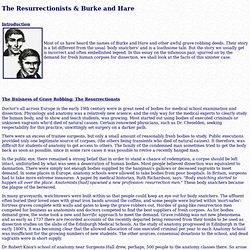
Their story is a bit different from the usual 'body snatchers' and is a loathsome tale. But the story we usually get is incorrect and often embellished legend. In this essay on the infamous pair, spurred on by the demand for fresh human corpses for dissection, we shall look at the facts of this sinister case. The Worlds of Burke and Hare. Echoes of the resurrection men. Penn Press Log: October 2009. Many ironies surround the life and body of Robert Knox.

Unlike the 16 people who William Burke and William Hare murdered and sold to anatomist Robert Knox for use in his teaching facilities, Knox died of natural causes. Knox's corpse was buried in tact in 1862, over 30 years after he and his underlings had dismembered and pickled the victims of Burke and Hare. Historian Lisa Rosner writes, "Robert Knox has been an enigma since his purchase of Burke's and Hare's cadavers was first made public. " How could a man of medicine be involved in a series of cold-blooded killings? How could a brilliant scientist fail to notice or suspect that the remarkably fresh bodies on his dissection table had been the victims of foul play?
It's important to note that although Dr. Still, Knox was well-known as a scientist with a keen mind. If Knox was a villain, perhaps his greatest sin was over-reaching ambition. Burke the Butcher and Hare the Thief. Suspicions were raised with the last murder, which took place at the lodging house. Lady Ann Gray and her husband James were staying at the lodging house when Marjorie Campbell Docherty was there. Mr. and Mrs. Gray left for the night, and then returned the next day to pick up some belongings that were left behind. Mrs. Gray grew suspicious when she was forbidden to approach the bed in which she slept the night before, she had left some stockings there.
Later that evening, the Grays were alone in the house, and Mrs. Even though there were numerous murders, there wasn’t much evidence, and so Hare took a deal where he would testify against Burke for immunity from prosecution. Burke was found guilty and hanged on January 28, 1829. MacDougal was released, but was almost lynched by a mob. Burke and Hare - Edinburgh Notes. Burke and Hare are probably the world's most famous graverobbers - although there is some question as to whether they ever actually robbed a grave.
The pair were both Irish but travelled to Scotland and met in Edinburgh where they were employed on the building of the Union Canal. In the early 1800s the medical sciences such as anatomy were growing at a rapid pace. Edinburgh, with its University and its school of anatomy, was at the forefront of this advance. Respectable surgeons - and many less respectable ones - needed a supply of bodies on which to operate. Unfortunately for them, the law regarding the use of bodies was strict. Resurrectionists The limited supply led to a market for the grave robbers, not just in Edinburgh. Edinburgh-Royal Mile-Burke and Hare. THE VIRTUAL VICTORIAN: THE MURDERERS BURKE AND HARE... Burke and Hare : Edinburgh Body Snatchers : Edinburgh-History.co.uk.
William Burke and William Hare were two Irish immigrants who scratched up 17 victims in Edinburgh over the years 1827 and 1829. What became known as the ‘West Port Murders’ made them the most famous body snatchers Scotland has ever seen. William Hare emigrated from Northern Ireland to the UK and worked along with many other Irish immigrants on the Union Canal before moving to Edinburgh where he ran a lodging house. William Burke was born in Urney, County Tyrone in 1792 and moved to Scotland around 1815.
He also found work as a navvy on the Union Canal, where it is suspected the two may have at first met. Edinburgh was then, as it is now, renowned for its spearheading of medical science. Burke and Hare Edinburgh Bad Boys and Serial Killers. If you thought Edinburgh history was all cute little stories about puppy dogs, think again. Edinburgh has a dark side, complete with a pair of serial killers who make Jack the Ripper look like a small time hood. In just eighteen months between 1827 and 1828, William Burke and William Hare murdered at least 16 people in Edinburgh and sold their corpses to Edinburgh’s Medical College.
Nice guys eh? How It Started. Burke and Hare the body snachers, Edinburgh, Scotland - UK History. The anatomy schools and the growing difficulty in obtaining freshly interred cadavers enter Burke and Hare, who devise their own and even more sinister methods of supplying the needs of the medical students.
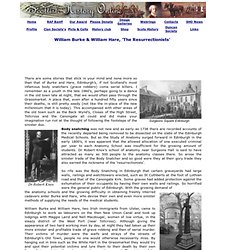
William Burke and William Hare, two Irish immigrants from Ulster, came to Edinburgh to work as labourers on the then New Union Canal and took up lodgings with Maggie Laird and Nell Macdougal, women of low virtue, in the sleazy district of the West Port (near Tollcross). Although giving the appearance of two hard working men by day, at night they had taken up their more sinister and profitable trade of grave robbing and then of serial murder. On the Trail of Burke and Hare. Burke and Hare, grave robbers and murderers. Burke and Hare, Edinburgh’s most ghoulish residents!
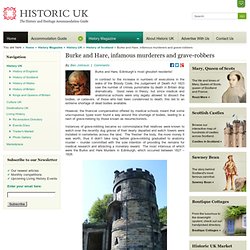
In contrast to the increase in numbers of executions in the wake of the Bloody Code, the Judgement of Death Act 1823 saw the number of crimes punishable by death in Britain drop dramatically. Good news in theory, but since medical and anatomical schools were only legally allowed to dissect the bodies, or cadavers, of those who had been condemned to death, this led to an extreme shortage of dead bodies available. However, the financial compensation offered by medical schools meant that some unscrupulous types soon found a way around this shortage of bodies, leading to a rash of grave-robbing by those known as resurrectionists. Instances of grave-robbing became so commonplace that relatives were known to watch over the recently dug graves of their dearly departed and watch towers were installed in cemeteries across the land.
Dr Knox. The Crimes - Burke and Hare: The Edinburgh Body Merchants on Crime and Investigation Network. Top 10 Famous Crime Couples. Crime is typically a matter of choice and criminals often use hidden reasons disguised as excuses to back up criminal acts.
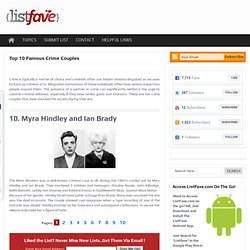
Misguided motivations of these individuals often have serious impactson people around them. The presence of a partner in crime can significantly reinforce the urge to commit criminal behavior, especially if they have similar goals and interests: These are ten crime couples that have shocked the society during their era: The Moor Murders was a well-known criminal case in UK during the 1960’s carried out by Myra Hindley and Ian Brady. They murdered 5 children and teenagers (Pauline Reade, John Kilbridge, Keith Bennett, Lesley Ann Downey and Edward Evans) in Saddleworth Moor, Greater Manchester Because of her gender, Hindley faced more public outrage than Brady. Many even assumed the she was the devil incarnate. William BURKE - Murderpedia, the encyclopedia of murderers. The Burke and Hare murders (also known as the West Port murders) were serial murders perpetrated in Edinburgh, Scotland, from November 1827 to 31 October 1828. The killings were attributed to Irish immigrants Brendan "Dynes" Burke and William Hare, who sold the corpses of their 17 victims to provide material for dissection.
Their purchaser was Doctor Robert Knox, a private anatomy lecturer whose students were drawn from Edinburgh Medical College. Their accomplices included Burke's mistress, Helen M'Dougal, and Hare's wife, Margaret Laird. From their infamous method of killing their victims has come the word "burking", meaning to purposefully smother and compress the chest of a victim. Historical background Before 1832, there were insufficient cadavers legitimately available for the study and teaching of anatomy in British medical schools.
Only about 2 or 3 corpses per year were available for a large number of students. William Burke: Mass murderer's death mask on display at Edinburgh University's Anatomy Museum. Death masks of Sir Walter Scott and Sir Isaac Newton also on display at University of Edinburgh’s Anatomy Museum By George Mair UPDATED: 16:32 GMT, 18 January 2012 The haunting facial cast of mass murderer William Burke, taken shortly before his execution, is to go on display later this month. It will be shown alongside Burke’s skeleton at the University of Edinburgh’s Anatomy Museum as part of an exhibition of medical artefacts. Together with accomplice William Hare, Burke carried out at least 15 murders in the 1820s and sold the bodies for use in anatomy lessons. Exhibit A: Dr Gordon Findlater holds the death mask of mass murderer William Burke, soon to go on public display.
1829: William Burke, eponymous body-snatcher. 1829: William Burke, eponymous body-snatcher January 28th, 2011 dogboy Wanted: corpses. Apply to Doctor Robert Knox, MD, FRSCEd, Professor of Medical Studies, Barclay’s Medical College, Surgeon’s Square, Edinburgh. William Hare. The Burke and Hare murders (also known as the West Port murders) were serial murders perpetrated in Edinburgh, Scotland, from November 1827 to 31 October 1828. The killings were attributed to Irish immigrants Brendan "Dynes" Burke and William Hare, who sold the corpses of their 17 victims to provide material for dissection. Their purchaser was Doctor Robert Knox, a private anatomy lecturer whose students were drawn from Edinburgh Medical College.
Their accomplices included Burke's mistress, Helen M'Dougal, and Hare's wife, Margaret Laird. From their infamous method of killing their victims has come the word "burking", meaning to purposefully smother and compress the chest of a victim. Historical background Before 1832, there were insufficient cadavers legitimately available for the study and teaching of anatomy in British medical schools. Only about 2 or 3 corpses per year were available for a large number of students. Burke & Hare Murder Dolls. Just a few years after the “Anatomy Murderers” Burke and Hare were apprehended in Edinburgh, two boys discovered these tiny dolls, each nested into a miniature coffin hidden away in the city park. At first theories on the dolls' significance ranged from witchcraft to child’s toys, but eventually it began to seem that the 17 tiny figures could be effigies for the 17 murder victims a decade earlier. Robert Knox.
Robert Knox c.1830 Robert Knox, FRSE FRCSE MWS (4 September 1791 – 20 December 1862) was a Scottish surgeon, anatomist and zoologist.
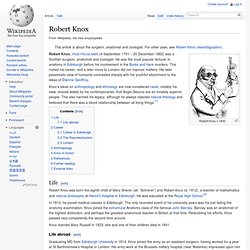
He was the most popular lecturer in anatomy in Edinburgh before his involvement in the Burke and Hare murders. This ruined his career, and a later move to London did not improve matters. His later pessimistic view of humanity contrasted sharply with his youthful attachment to the ideas of Étienne Geoffroy. Dr Robert Knox.
Anatomist and ethnologist.
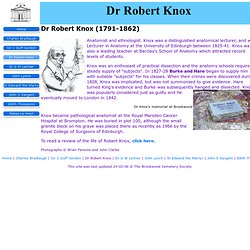
Robert Knox. The Anatomist (TV 1939. Play of the Month: The Anatomist (1980) @ EOFFTV. Burke and Hare (2010)